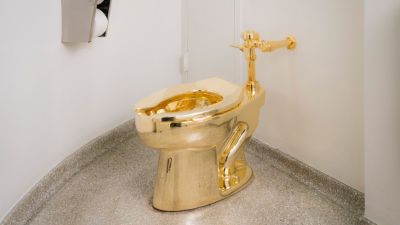Maurizio Cattelan è uno dei più importanti artisti italiani in attività ed il più quotato al momento sul mercato. Da sempre irriverente nei confronti delle istituzioni e dell’establishment culturale, le sue opere ironiche e provocatorie hanno il merito di suscitare immancabilmente scalpore, indignazione e scandalo in un’opinione pubblica che ormai sembra abituata a tutto. L’invito è a non prendersi troppo sul serio perché così si finisce per diventare cinici, freddi e distaccati mentre l’arte ha l’obiettivo di suscitare emozioni forti. America, l’opera più recente di Cattelan è un wc d’oro a diciotto carati installato al museo Guggenheim di New York, che potrà essere utilizzata dal pubblico “quando la natura chiama.”
Maurizio Cattelan, born on September 21, 1960 in Padua, Italy, has gained a reputation as an art scene’s joker. Often described as the art world’s resident prankster and provocateur, his art makes fun of various systems of order – be it social niceties or his regular digs at the art world – and is often based on simple puns and dark humor.
Some of his most talked about pieces include “Turisti,” his work for the 2011 Venice Biennial made up of 2,000 embalmed pigeons and “HIM” (2001), a sculpture resembling a schoolboy kneeling in prayer, except that the head has been replaced with the realistic likeness of Adolf Hitler. “La Nona Ora” (The Ninth Hour), 1999, is one of his most famous works. It is a sculpture of Pope John Paul II hit by a meteorite. The sculpture was sold at Christie’s for $886,000. In 2011, Cattelan retired by hanging an exhibit of nearly all of his work (128 pieces) on the skylight at the top of the Guggenheim Museum atrium in NYC.
Earlier this year, Cattelan emerged from his self-imposed hiatus with a new work. “America” has been installed at the Guggenheim and is a fully functional, 18 karat gold toilet. The golden throne is open to the public, protected by a security guard and cleaned by custodians every 15 minutes. “Cattelan’s toilet offers a wink to the excesses of the art market, but also evokes the American dream of opportunity for all, its utility ultimately reminding us of the inescapable physical realities of our shared humanity,” the Guggenheim announced in a press release. When asked about the piece by The New Yorker, Maurizio Cattelan, himself, stated “Whatever you eat, a two-hundred-dollar lunch or a two-dollar hot dog, the results are the same, toilet-wise.”



